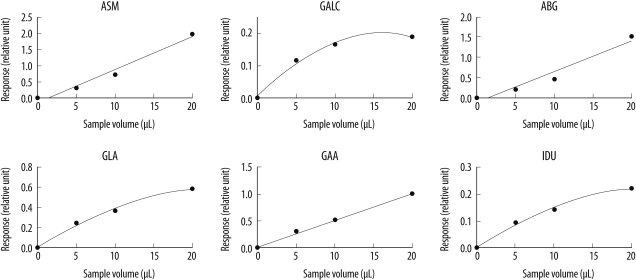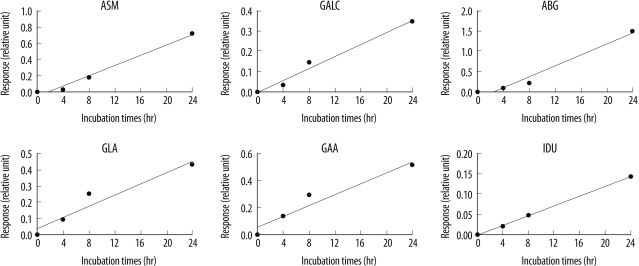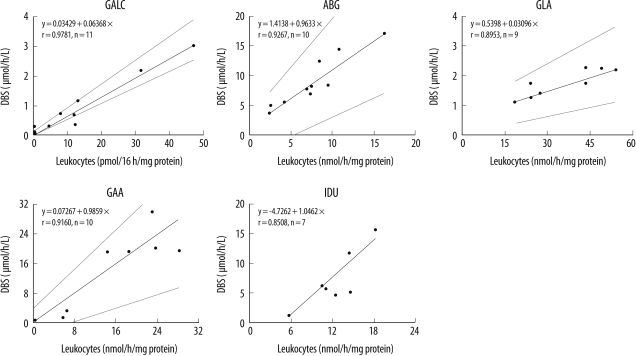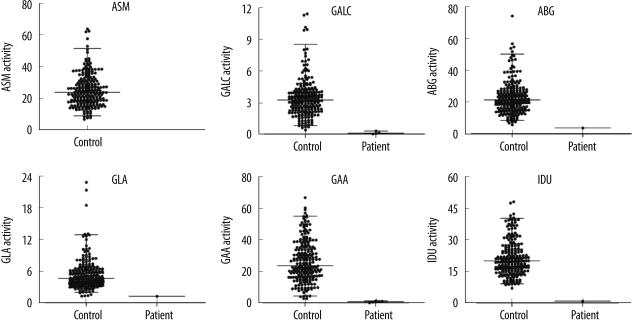Korean J Lab Med.
2011 Oct;31(4):250-256. 10.3343/kjlm.2011.31.4.250.
Use of Tandem Mass Spectrometry for Newborn Screening of 6 Lysosomal Storage Disorders in a Korean Population
- Affiliations
-
- 1Department of Laboratory Medicine, Seoul National University Bundang Hospital, Seongnam, Korea. songjhcp@snu.ac.kr
- 2Department of Laboratory Medicine, Seoul National University College of Medicine, Seoul, Korea.
- 3Konkuk University, Seoul, Korea.
- KMID: 1781688
- DOI: http://doi.org/10.3343/kjlm.2011.31.4.250
Abstract
- BACKGROUND
We evaluated the performance of multiplex tandem mass spectrometry (MS/MS) in newborn screening for detection of 6 lysosomal storage disorders (LSDs), namely, Niemann-Pick A/B, Krabbe, Gaucher, Fabry, and Pompe diseases and Hurler syndrome.
METHODS
We revised the conditions and procedures of multiplex enzyme assay for the MS/MS analysis and determined the precision of our enzyme assay and the effects of sample amounts and incubation time on the results. We also measured the degree of correlation between the enzyme activities in the dried blood spots (DBSs) and those in the leukocytes. DBSs of 211 normal newborns and 13 newborns with various LSDs were analyzed using our revised methods.
RESULTS
The intra- and inter-assay precisions were 2.9-18.7% and 8.1-18.1%, respectively. The amount of product obtained was proportional to the DBS eluate volume, but a slight flattening was observed in the product vs. sample volume curve at higher sample volumes. For each enzyme assay, the amount of product obtained increased linearly with the incubation period (range, 0-24 hr). Passing and Bablok regression analysis revealed that the enzyme activities in the DBSs and those in the leukocytes were favorably correlated. The enzyme activities measured in the DBSs were consistently lower in patients with LSDs than in normal newborns.
CONCLUSIONS
The performance of our revised techniques for MS/MS detection and enzyme assays was of the generally acceptable standard. To our knowledge, this is the first report on the use of MS/MS for newborn screening of LSDs in an Asian population.
Keyword
MeSH Terms
Figure
Cited by 2 articles
-
Ultra-Performance Liquid Chromatography-Tandem Mass Spectrometry Measurement of Leukocyte Arylsulfatase A Activity Using a Natural Substrate
Minje Han, Sun-Hee Jun, Sang Hoon Song, Hyung-Doo Park, Kyoung Un Park, Junghan Song
Ann Lab Med. 2015;35(1):165-168. doi: 10.3343/alm.2015.35.1.165.A Questionnaire Survey on General Status and Opinions about Clinical Mass Spectrometric Analysis in Korea (2018)
Sung-Eun Cho, Hyojin Chae, Hyung-Doo Park, Sail Chun, Yong-Wha Lee, Yeo-Min Yun, Sang Hoon Song, Sang-Guk Lee, Kyunghoon Lee, Junghan Song, Soo-Youn Lee
Lab Med Online. 2019;9(3):161-165. doi: 10.3343/lmo.2019.9.3.161.
Reference
-
1. Futerman AH, van Meer G. The cell biology of lysosomal storage disorders. Nat Rev Mol Cell Biol. 2004; 5:554–565. PMID: 15232573.
Article2. Meikle PJ, Hopwood JJ, Clague AE, Carey WF. Prevalence of lysosomal storage disorders. JAMA. 1999; 281:249–254. PMID: 9918480.
Article3. Chace DH, Kalas TA, Naylor EW. Use of tandem mass spectrometry for multianalyte screening of dried blood specimens from newborns. Clin Chem. 2003; 49:1797–1817. PMID: 14578311.
Article4. Lehotay DC, Hall P, Lepage J, Eichhorst JC, Etter ML, Greenberg CR. LC-MS/MS progress in newborn screening. Clin Biochem. 2011; 44:21–31. PMID: 20709048.
Article5. Ko DH, Jun SH, Park HD, Song SH, Park KU, Kim JQ, et al. Multiplex enzyme assay for galactosemia using ultraperformance liquid chromatography-tandem mass spectrometry. Clin Chem. 2010; 56:764–771. PMID: 20299679.
Article6. Ko DH, Jun SH, Park KU, Song SH, Kim JQ, Song J. Newborn screening for galactosemia by a second-tier multiplex enzyme assay using UPLC-MS/MS in dried blood spots. J Inherit Metab Dis. 2011; 34:409–414. PMID: 21340634.
Article7. Li Y, Scott CR, Chamoles NA, Ghavami A, Pinto BM, Turecek F, et al. Direct multiplex assay of lysosomal enzymes in dried blood spots for newborn screening. Clin Chem. 2004; 50:1785–1796. PMID: 15292070.
Article8. Zhang XK, Elbin CS, Chuang WL, Cooper SK, Marashio CA, Beauregard C, et al. Multiplex enzyme assay screening of dried blood spots for lysosomal storage disorders by using tandem mass spectrometry. Clin Chem. 2008; 54:1725–1728. PMID: 18719200.
Article9. Chamoles NA, Blanco M, Gaggioli D. Diagnosis of alpha-L-iduronidase deficiency in dried blood spots on filter paper: the possibility of newborn diagnosis. Clin Chem. 2001; 47:780–781. PMID: 11274042.10. Wang D, Eadala B, Sadilek M, Chamoles NA, Turecek F, Scott CR, et al. Tandem mass spectrometric analysis of dried blood spots for screening of mucopolysaccharidosis I in newborns. Clin Chem. 2005; 51:898–900. PMID: 15695324.
Article11. Blanchard S, Sadilek M, Scott CR, Turecek F, Gelb MH. Tandem mass spectrometry for the direct assay of lysosomal enzymes in dried blood spots: application to screening newborns for mucopolysaccharidosis I. Clin Chem. 2008; 54:2067–2070. PMID: 19042989.
Article12. Duffey TA, Bellamy G, Elliott S, Fox AC, Glass M, Turecek F, et al. A tandem mass spectrometry triplex assay for the detection of Fabry, Pompe, and mucopolysaccharidosis-I (Hurler). Clin Chem. 2010; 56:1854–1861. PMID: 20940330.
Article13. Duffey TA, Sadilek M, Scott CR, Turecek F, Gelb MH. Tandem mass spectrometry for the direct assay of lysosomal enzymes in dried blood spots: application to screening newborns for mucopolysaccharidosis VI (Maroteaux-Lamy syndrome). Anal Chem. 2010; 82:9587–9591. PMID: 20961069.
Article14. Khaliq T, Sadilek M, Scott CR, Turecek F, Gelb MH. Tandem mass spectrometry for the direct assay of lysosomal enzymes in dried blood spots: application to screening newborns for mucopolysaccharidosis IVA. Clin Chem. 2011; 57:128–131. PMID: 21030685.
- Full Text Links
- Actions
-
Cited
- CITED
-
- Close
- Share
- Similar articles
-
- Perspectives on Next-Generation Newborn Screening
- Screening newborns for metabolic disorders based on targeted metabolomics using tandem mass spectrometry
- A Case of Maple Syrup Urine Disease detected by Tandem Mass Spectrometry in Newborn Screening Test
- Seven-year experience with inherited metabolic disorders screening by tandem mass spectrometry
- Isolated 3-Methylcrotonyl CoA Carboxylase Deficiency Detected by Newborn Screening Program Using Tandem Mass Spectrometry





